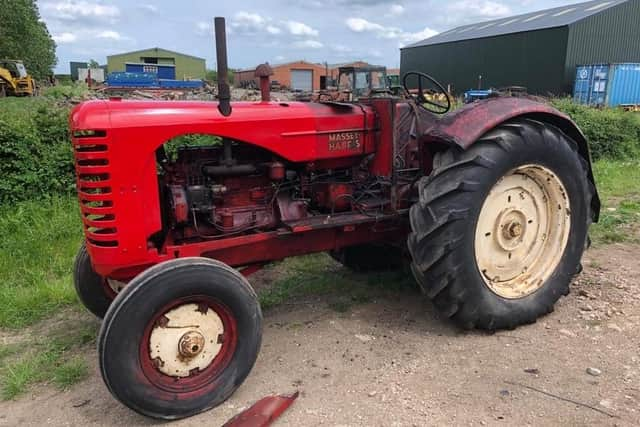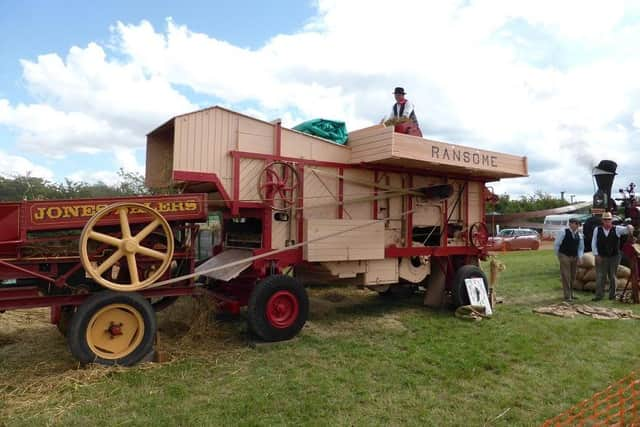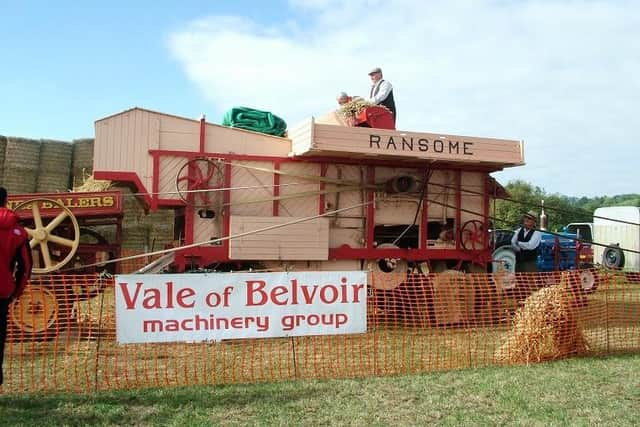Power of the past at Newark Vintage Tractor and Heritage Show with over 1,000 models and pieces of equipment on display or in action
and live on Freeview channel 276
Many of these paved the way for modern-day machinery, including a 1950 Ransome Threshing Machine no. 61374 threshing drum and Massey Harris 55K, LAL 140 tractor, which have recently been restored and reunited after 50 years.
Ben and his father Jim Craig, tractor restorers based near Harby, led the restoration, with help from the Vale of Belvoir Machinery Group – and both have a real personal connection with both machines.
Advertisement
Advertisement
Ben commented: “The tractor has real sentimental value to my father - he remembers seeing it as a child, being used by contractors, as he walked to school.


“The Beeby Brothers (agricultural contractors), who owned the threshing drum originally, weren’t far from where we used to live – so it is great being able to reunite the threshing drum with its original tractor.”
It was by chance that the owner of the tractor – John Hayward - saw the threshing drum at a show.
“We didn’t know about the existence of the tractor, but he came to a show and told us he had the tractor that went with the threshing drum and it should be reunited.
Advertisement
Advertisement
“We’re still working on restoring the cab, but the tractor will be mostly finished in time for the Newark Vintage Tractor and Heritage Show.


“We will be driving the threshing drum at the show, and we hope to take it around to other shows in the future.”
There are various celebrations taking place at the show, one of which is Nicholson’s of Newark.
Originally established as WN Nicholson and Sons in 1825, the agricultural machinery manufacturer was based at Trent Iron Works, Newark.
Advertisement
Advertisement
Vintage enthusiast, Michael Hart, recalled: “Over the years they made many different types of haymaking machinery including rakes, swathers and tedders.


“They also made fertiliser distributors and cultivators, grinding mills and sugar beet hoes. In 1912 they introduced the bulldog stationary engine, but only two were built and the one preserved will hopefully be coming to the Show - owned by stationary enthusiast Matthew Alcock.”
Mr Hart worked for JL Maltby agricultural engineers and iron mongers after leaving school in 1958 – located on the opposite side of the river to Nicholson’s.
He continued: “As a young lad I was often sent to pick up parts from Nicholson’s. One day I went to pick up a part for a swath turner.
Advertisement
Advertisement
“When I got there the part was still in the works and I could not take it until painting had been finished. So, the parts manager Tom Aslin tied a piece of string around it and dipped it in Nicholson’s light blue paint. I then had to head back over the Trent bridge and back to Maltby’s without dripping any paint,” he laughed.
Mr Hart also remembers seeing implements being loaded onto train wagons, with those destined for Ireland fitted with horse shafts rather than a tractor draw bar. But Nicholson’s was perhaps best known for its sugar beet implement.
He added: “Nicholson’s made Britain’s bestselling sugar beet hoe, the BT08, which could be fitted to a tractor’s three-point linkage, or front mounted on Nuffield and Allis Chalmers tractors.”
Having been a local institution, visitors to the Newark Vintage Tractor and Heritage Show will be able to see a range of Nicholson’s machinery on display, with 11 exhibits in total.
Advertisement
Advertisement
Another celebration taking place will be for one of the largest stationary engine manufacturers – Ruston and Hornsby. The company was established in September 1918 due to a merger between Ruston Proctor and Co of Lincoln and Richard Hornsby and Sons of Grantham.
Mike Milestone, chair of the National Vintage Tractor and Engine Club (NVTEC) East Yorkshire, stated: “Both of these companies have histories tracing back into Victorian times and were among the UK’s early stationary engine manufacturers.”
But the company didn’t just make engines and is equally famous for building a variety of other equipment.
“These include threshing machines, tractors, aircraft, cars, rail locomotives, boilers, water pumps and gas turbines,” he said.
Advertisement
Advertisement
Following the merger in 1918, existing engines from both companies were still offered, and work was undertaken to design new models.
“The first engine to be designed and sold by Ruston and Hornsby was the Industrial Paraffin (IP) range which was introduced in 1920.
“This shared several characteristics with the earlier Richard Hornsby Stockport range, but with several modifications. Shortly after the introduction of the IP, a lower cost version aimed at the agricultural market was introduced and named the Agricultural Paraffin (AP) range. Both AP and IP engines are now highly desired by collectors,” added Mr Milestone.
The first of its large industrial engines was the M-type semi diesel engine but most famous was the HR range of horizontal diesel engines.
Advertisement
Advertisement
“These were in production from the 1920s until the late 1960s. It’s testament to the quality of these machines that there are still numerous examples in service throughout the world.
“Many are still in use in Lincolnshire where they are used to drive water pumps to prevent the low-lying Fenland from flooding. They are also being used to pump water in the Trent Valley too.”
Being able to celebrate these institutions of agricultural machinery is something that really makes the show special and unique, show organiser Elizabeth Halsall remarked.
“Seeing these machines and equipment steeped in history all in one place is a real treat. The show will be one of the biggest gatherings of vintage tractors, engines, machinery, commercial and military vehicles in the country,” she added.